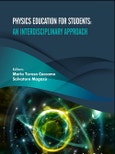Physics Education for Students: An Interdisciplinary Approach, with its selection of expert reviews is an interesting read for academics and researchers involved in STEM education, at the school or college level.
Table of Contents
Chapter 1 Expansive Framing Produces More Vivid Introductory- Physics Labs
- Danny J. Doucette and Chandralekha Singh
- Introduction
- Physics Labs
- Biomedical Applications
- Nature of Science
- Conclusion
- Consent for Publication
- Conflict of Interest
- Acknowledgements
- References
Chapter 2 Active Learning in Studying Physics as the First Research
- Experience of University Students
- Introduction
- Organization of Project Activities in Physics
- Involving Students in Performing a Demonstration Experiment in Physics
- Students’ Preparation for Seminar Presentations on the Topics That Require Physical
- Demonstrations
- Students’ Development of Working Models of Devices That Demonstrate Physical
- Phenomena and Processes
- Students’ Research on Physical Topics
- Organization of Interdisciplinary Project Work
- Conclusion
- Consent for Publication
- Conflict of Interest
- Acknowledgements
- References
Chapter 3 Can Physics Education Support a Self-Responsible Society?
- Gilbert Ahamer
- Introduction
- Physics Labs First Didactic Method “3×7 = 21”
- Didactic Basics of the Course Design “3×7 = 21”
- Considering Several Value Systems Means an Inter-Paradigmatic Approach
- The Concrete Didactic Process of “3 X 7 = 21”
- Reflection of the “3 X 7 = 21” Process
- Web Design for “3 X 7 = 21”
- Second Didactic Method: The Jet Principle in E-Learning
- Introduction and Motivation for the “Jet Principle”
- Understanding the Design of the “Jet Principle”
- Inventing a “Jet Engine” for Smoothing Learning Processes
- Symbolic Interpretation of the Analogy with a Jet Engine
- Elena Kazakova, Svetlana Kirpu, Marina Kruchek, Elena Moshkina, Olga Sergeeva Dqg
- Elena Tikhomirova
- The “Jet Principle” in (E-)Learning
- Description of the “Jet Principle” Process
- Summary of the “Jet Principle” Process
- Web Design for the “Jet Principle” in E-Learning
- Conclusions
- Consent for Publication
- Conflict of Interest
- Acknowledgements
- References
Chapter 4 Dialogic Best Practice for Dissemination of a Scientific
- Culture
- Gilbert Ahamer
- Surfing Global Change
- Pedagogic Foundation of the Negotiation Game “Surfing Global Change”
- Interdisciplinarity
- A Variety of Value Systems: Becoming Interparadigmatic
- The Rules for the Game “Surfing Global Change”
- Overview of the Game “Surfing Global Change”
- Basics of Web Design for Sgc
- Conclusions
- Consent for Publication
- Conflict of Interest
- Acknowledgements
- References
Chapter 5 Research-Based Proposals on Optical Spectroscopy in Secondary School
- Daniele Buongiorno and Marisa Michelini
- Introduction
- The Research Perspective
- The General Structure of the Educational Path
- Context, Sample and Methodology
- Data Analysis
- Masterclass(C) Experimentation: Post-Test
- Summer School Experimentation: Pre- and Post-Test
- Conclusions
- Consent for Publication
- Conflict of Interest
- Acknowledgements
- References
Chapter 6 Normal Mode Investigation of a System of Coupled
- Oscillators: a Physics Lecture
- Introduction
- Theoretical Background
- Experimental Set-Up
- Experimental Procedure
- Experimental Data
- Data Analysis
- Historical Background: Fourier and Wavelet Transforms
- Application of Fourier and Wavelet Transforms
- Concluding Remarks
- Consent for Publication
- Conflict of Interest
- Acknowledgements
- References
Author
- Maria Teresa Caccamo
- Salvatore Magazù








